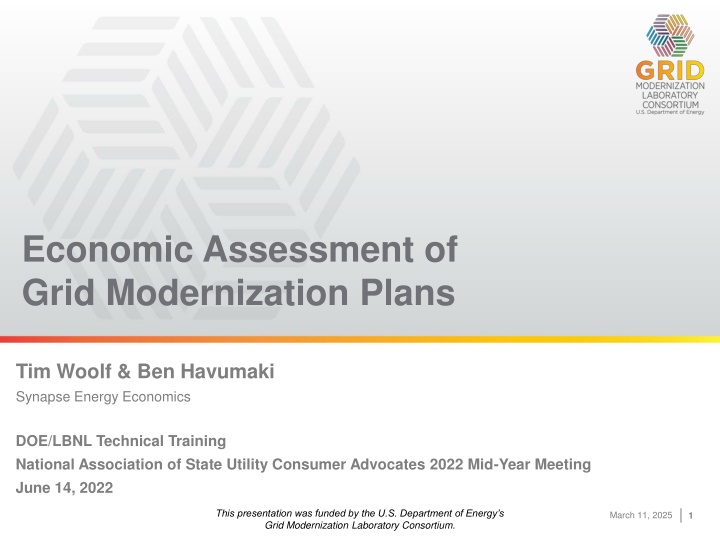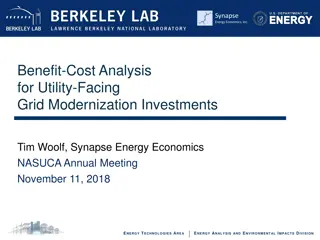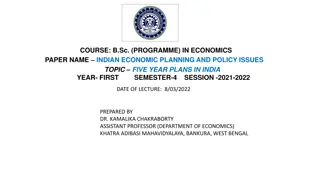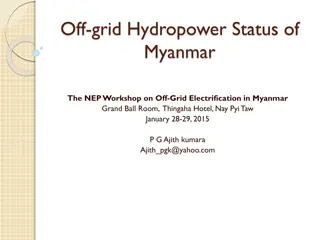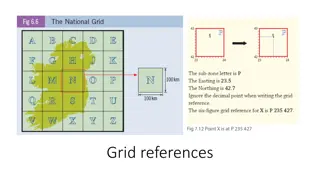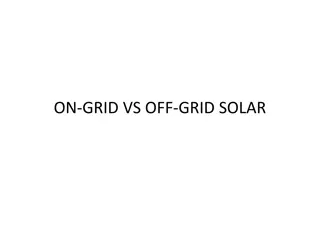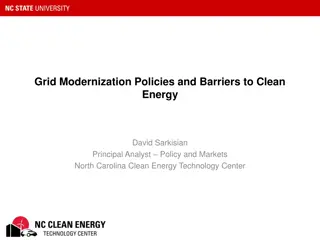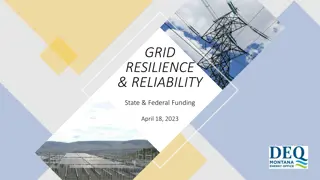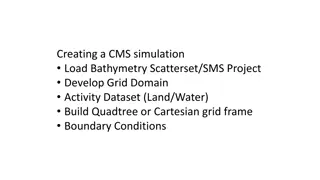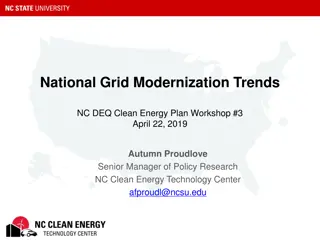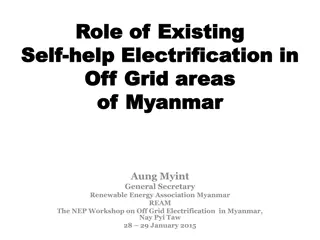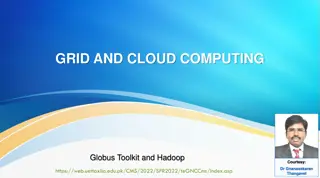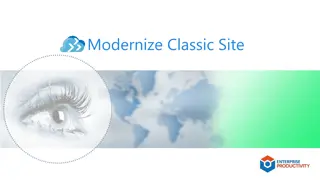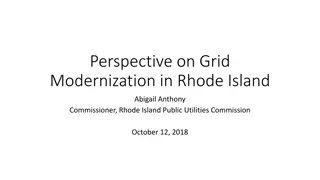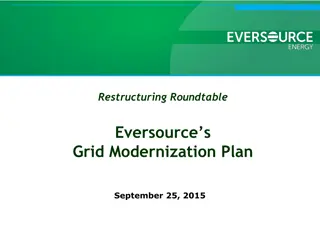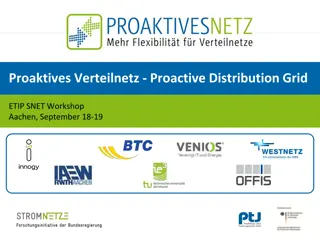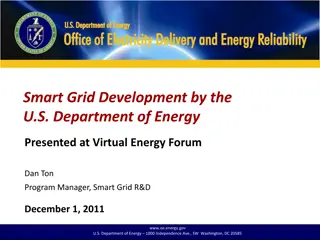Economic Assessment of Grid Modernization Plans
This presentation discusses the economic evaluation of grid modernization plans, including benefit-cost analysis, interdependencies between components, hard-to-quantify benefits, and customer equity. It reviews specific utility grid mod plans and identifies key aspects often lacking in these plans. Recommendations are provided based on recent studies and expert insights.
Download Presentation

Please find below an Image/Link to download the presentation.
The content on the website is provided AS IS for your information and personal use only. It may not be sold, licensed, or shared on other websites without obtaining consent from the author.If you encounter any issues during the download, it is possible that the publisher has removed the file from their server.
You are allowed to download the files provided on this website for personal or commercial use, subject to the condition that they are used lawfully. All files are the property of their respective owners.
The content on the website is provided AS IS for your information and personal use only. It may not be sold, licensed, or shared on other websites without obtaining consent from the author.
E N D
Presentation Transcript
Economic Assessment of Grid Modernization Plans Tim Woolf & Ben Havumaki Synapse Energy Economics DOE/LBNL Technical Training National Association of State Utility Consumer Advocates 2022 Mid-Year Meeting June 14, 2022 This presentation was funded by the U.S. Department of Energy s Grid Modernization Laboratory Consortium. March 11, 2025 March 11, 2025 1 1
Overview Review of several utility Grid Mod Plans General guidance on economic evaluation of Grid Mod Plans Benefit-cost analysis (BCA) versus least-cost/best-fit (LCBF) Accounting for interdependencies between grid mod components Accounting for hard to quantify benefits Accounting for customer equity Based on two recent studies T. Woolf, B. Havumaki, D. Bhandari, M. Whited and L. Schwartz, Benefit-Cost Analysis for Utility-Facing Grid Modernization Investments: Trends, Challenges, and Considerations, Berkeley Lab, 2021. Minnesota Department of Commerce, Review and Assessment of Grid Modernization Plans: Guidance for Regulators, Utilities, and Other Stakeholders, prepared by Synapse Energy Economics, 2022. (Docket No. E002/M-21-814, available through eDockets) Synapse Energy Economics March 11, 2025 March 11, 2025 2 2
Review of Benefit-Cost Analyses in Grid Modernization Plans Synapse Energy Economics March 11, 2025 March 11, 2025 3 3
Review of BCAs in 21 Grid Mod Plans Utility State Year Utility State Year National Grid NY 2016 DTE Energy MI 2018 NYSEG & RGE NY 2016 APS AZ 2016 Unitil MA 2015 PSE&G NJ 2018 National Grid MA 2016 LGE KY 2018 Eversource MA 2015 Consumers Energy MT 2018 Public Service Co. CO 2016 Central Hudson G&E NY 2018 SDGE CA 2016 Hawaiian Electric Cos HI 2017 Xcel MN 2017 Southern CA Edison CA 2016 FirstEnergy OH 2017 CT Light & Power CT 2010 Vectren IN 2017 Entergy AR 2016 National Grid RI 2018 Source: Woolf et al., Benefit-Cost Analysis for Utility-Facing Grid Modernization Investments, prepared for Berkeley Lab, 2021. Synapse Energy Economics March 11, 2025 March 11, 2025 4 4
Review of Grid Mod Plans: Themes Key items that were generally lacking: An overarching rationale for grid modernization investments and an explanation of how individual components will help meet overall goals Identification of which cost-effectiveness test was used for the BCA Identification of which discount rate was used to determine present values Methodologies to account for the interdependencies of grid modernization components Methodologies to account for unmonetized benefits of grid modernization components Robust definitions of grid modernization metrics and how they will be used to monitor grid modernization costs and benefits over time Methodologies and discussions for addressing customer equity issues Source: Woolf et al., Benefit-Cost Analysis for Utility-Facing Grid Modernization Investments, prepared for Berkeley Lab, 2021. Synapse Energy Economics March 11, 2025 March 11, 2025 5 5
Type and Frequency of Claimed Benefits Source: Woolf et al., Benefit-Cost Analysis for Utility-Facing Grid Modernization Investments, prepared for Berkeley Lab, 2021. Synapse Energy Economics March 11, 2025 March 11, 2025 6 6
Type and Frequency of Monetized Benefits Source: Woolf et al., Benefit-Cost Analysis for Utility-Facing Grid Modernization Investments, prepared for Berkeley Lab, 2021. Synapse Energy Economics March 11, 2025 March 11, 2025 7 7
Economic Evaluation of Grid Modernization Plans Synapse Energy Economics March 11, 2025 March 11, 2025 8 8
Grid Mod Regulatory Contexts Utility seeking review of costs before spending Typically, in a case dedicated to review of proposed investments Allows for focused review of proposal (outside rate case) Sometimes initiated by commission, sometimes by the utility Utility often asks for some form of regulatory guidance or approval Implications of regulatory guidance or approval vary by state Utility seeking recovery of costs after spending Typically, in a rate case Allows for retrospective prudence review Allows for review in context of other utility costs Grid modernization issues might be one of many contentious issues Difficult to modify, reduce, or disallow costs after they are spent Most grid modernization plans are submitted before spending Synapse Energy Economics March 11, 2025 March 11, 2025 9 9
Examples of Grid Mod Benefits Utility System Benefit Society Reduced O&M costs Reduced generation capacity costs Reduced energy costs Reduced T&D costs and losses Reduced ancillary services costs Increased system reliability Increased safety Increased resilience Increased distributed energy resource (DER) integration Improved power quality Reduced customer outage costs Increased customer satisfaction Increased customer flexibility and choice Reduced environmental compliance costs Environmental benefits Economic development benefits Synapse Energy Economics March 11, 2025 March 11, 2025 10 10
Examples of Grid Mod Costs Cost Utility System Society Incremental capital costs for grid modernization equipment - Incremental O&M costs for grid modernization equipment - Incremental costs for T&D upgrades needed to support the grid modernization equipment - Program administration costs - Grid modernization costs are typically recovered from all customers. But the benefits might not be experienced by all customers. Grid modernization costs are relatively easy to quantify and monetize. But the benefits are sometimes hard to quantify and monetize. Synapse Energy Economics March 11, 2025 March 11, 2025 11 11
Interdependence of Components Source: Adapted from World Bank, Practical Guidance for Defining a Smart Grid Modernization Strategy: The Case of Distribution, 2017. For definition of terms, see glossary in US DOE, Modern Distribution Grid: Strategy & Implementation Guidebook, 2020 Tim Woolf - Synapse Energy Economics Synapse Energy Economics March 11, 2025 March 11, 2025 12 12
Core Components Versus Applications Source: US DOE, Modern Distribution Grid: Strategy & Implementation Guidebook, 2020, page 59. Synapse Energy Economics March 11, 2025 March 11, 2025 13 13
Principles for Grid Mod Economic Analysis 1. Compare consistently with traditional resources or technologies 2. Clearly account for state regulatory and policy goals 3. Account for all relevant costs and benefits, including those difficult to monetize 4. Consider interdependencies between components where feasible 5. Consider customer equity issues 6. Provide symmetry across relevant costs and benefits 7. Apply a full life-cycle analysis 8. Provide a sufficient incremental and forward-looking view 9. Ensure transparency 10. Avoid combining or conflating different costs and benefits 11. Address locational and temporal values Source: Minnesota Department of Commerce, Review and Assessment of Grid Modernization Plans: Guidance for Regulators, Utilities, and Other Stakeholders, prepared by Synapse Energy Economics, Attachment to Department of Commerce Letter. Docket No. E002/M- 21-814, February 9, 2022 Synapse Energy Economics March 11, 2025 March 11, 2025 14 14
Articulate Grid Modernization Goals Sample Goal Sample Objectives and Targets Sample Metric and Reporting DER capacity 50% of minimum recorded load on 25% of circuits by 2025 Annual report by circuit: DER capacity Accommodate higher capacities of DERs Minimum recorded load DER capacity 100% of minimum recorded load on 50% of circuits by 2030 Annual report by circuit: DER capacity 100% of maximum recorded load on 50% of circuits by 2035 DER capacity Maximum recorded load Interconnection decisions rendered on systems under 10 kW within 5 business days on circuits with available distributed energy resource capacity. Annual reports: Interconnection requests by size Avoid interconnection delays Interconnection decisions rendered on systems between 10 and 100 kW within 30 days on circuits with available distributed energy resource capacity Date of each request Date on which decision was communicated for each request Interconnection decisions rendered on systems over 100 kW within 90 days Source: Minnesota Department of Commerce, Review and Assessment of Grid Modernization Plans: Guidance for Regulators, Utilities, and Other Stakeholders, Attachment to Department of Commerce Letter. Docket No. E002/M-21-814, February 9, 2022 Synapse Energy Economics March 11, 2025 March 11, 2025 15 15
Example performance metrics Example benefit Example performance metrics DER deployment Number of DER installations Performance metrics can be used to indicate the extent to which purported benefits will be achieved. Customer satisfaction Customer ratings, customer engagement metrics Reliability System-wide or targeted SAIDI, SAIFI, CAIDI, CAIFI Resilience Restoration time after extreme weather events Safety Number of safety events, injuries, deaths Network and data access Interconnection times, data access times, developer satisfaction Retail competition Number of customers choosing a competitive option Synapse Energy Economics March 11, 2025 March 11, 2025 16 16
Benefit-Cost Analysis versus Least-Cost/Best-Fit Analysis Synapse Energy Economics March 11, 2025 March 11, 2025 17 17
Description of BCA and LCBF Least-Cost/Best-Fit For investments where the need has been established Ex: A new distribution line is needed to provide service to a new residential development. Different options might be considered for how to meet the need. Ex. Different paths, different combinations of transformers, substations, etc. LCBF is used to determine the option that meets the need at the lowest cost Does not necessarily require quantifying or monetizing the benefits Benefit-Cost Analysis For determining whether to make an investment BCA used to determine whether the investment will result in net benefits Typically includes monetizing, or at least quantifying, all costs and benefits The line between these two approaches is not always clear. Synapse Energy Economics March 11, 2025 March 11, 2025 18 18
BCA Versus Least-Cost/Best-Fit Need Purpose Application Costs Benefits Not Required Benefits are not necessarily accounted for; presumed to be worth the costs Need for the investment has been established To identify the investment that meets the need at lowest cost Which option is the lowest-cost way to meet the need? Included Typically includes only utility system costs Least-Cost/ Best-Fit Included Extent of benefits depends upon BCA test chosen Need for the investment has not been established To determine whether to make the proposed investment Do the benefits of the investment outweigh the costs? Included Extent of costs depends upon BCA test chosen BCA Synapse Energy Economics March 11, 2025 March 11, 2025 19 19
Economic Evaluation Options (from DOE) Joint and interdependent benefits core platform investments needed to enable new capabilities and functions Standards compliance and policy mandates utility investments needed to comply with safety and reliability standards or to meet policy mandates Net customer benefits utility investments from which some or all customers receive net benefits in the form of bill savings Customer choice customer-driven projects paid for by individual customers Source: US DOE, Modern Distribution Grid: Strategy & Implementation Guidebook, 2020, page 113. Synapse Energy Economics March 11, 2025 March 11, 2025 20 20
BCA Versus Least-Cost/Best-Fit The main difference LCBF presumes that the utility investment is needed. Therefore, the benefits of the investment are not necessarily monetized. BCA is used to justify the investment. Benefits are monetized to demonstrate that the investment will have net benefits. LCBF has been used for distribution planning for many years. Because it was applied to investments that were clearly needed to maintain reliability Ex: A new substation needs to be upgraded to serve an increasing customer demand. What is the least-cost technology for upgrading the substation? Now, there are more options to consider. Ex: A non-wires alternative could be implemented instead of a substation upgrade A BCA should be conducted to determine which has greater net benefits. Synapse Energy Economics March 11, 2025 March 11, 2025 21 21
Is There a Need for the Investment? For grid mod investments, the need is often not clear Is an automated distribution management system (ADMS) necessary? Is advanced metering infrastructure (AMI) necessary? Is Volt-Var Optimization (VVO) necessary? Grid modernization is sometimes described as necessary, but some components might not be, and some components might have costs that exceed the benefits. A better question to ask: Will the grid mod investment result in net benefits? This is the key question for Commissions, Commission staff, and consumer advocates This question can be answered only by a BCA Therefore, BCA should be given priority over LCBF for grid mod evaluations BCAs provide value even if the need for grid mod investment seems clear The BCA information on benefits is helpful (a) at the time of the investment decision, and (b) after the investment has been made, to monitor performance over time. Synapse Energy Economics March 11, 2025 March 11, 2025 22 22
When Should BCA Be Used Instead of LCBF? Reasons Not to Conduct a BCA Responses There are ways to account for benefits without monetizing them. Some benefits are too hard to monetize. Some grid mod components are necessary to support other elements, and it is difficult to isolate, quantify, or monetize the benefits. BCAs can be used to assess interdependencies between components. Some grid mod components work jointly with other components, and it is difficult to isolate, quantify, or monetize the benefits. BCAs can be used to assess interdependencies between components. This reason is not sufficient to justify LCBF, given the utility is proposing to spend millions of dollars on grid modernization. A BCA might be expensive and burdensome. Answer: BCA should be the default approach. An LCBF may be appropriate in certain situations. March 11, 2025 March 11, 2025 23 23
BCA Provides More Information than LCBF BCAs provide more transparency, even if all the benefits are not quantified. Costs / Benefits (mil PV$) Type of Cost or Benefit LCBF BCA #1 BCA #2 Costs Capital, O&M, administration 20 20 20 Benefits monetized Energy, capacity, O&M, T&D ? 18 12 Benefits not monetized Reliability & resilience ? ? ? Net benefits --- ? -2 -8 Benefit-cost ratio --- ? 0.9 0.6 Result #1: This component might be deemed to be cost-effective because the reliability and resilience benefits are worth the $2 million net cost. Result #2: This component might be deemed to be not cost-effective because the reliability and resilience benefits are not worth the $8 million net cost. Synapse Energy Economics March 11, 2025 March 11, 2025 24 24
Accounting for Interdependencies, Hard to Quantify Benefits, and Customer Equity Synapse Energy Economics March 11, 2025 March 11, 2025 25 25
Accounting for Interdependences Apply LCBF if necessary. The use of LCBF must be justified in the Grid Mod Plan. Apply BCA tests for each component in isolation. Using a BCA test appropriate for your state Apply BCA to several scenarios where components are bundled in different ways. Start with just platform components Add layers of application components on top of platform components Assess how the BCA results change with different combinations of components Synapse Energy Economics March 11, 2025 March 11, 2025 26 26
Accounting for Interdependences: Example Scenario 2: Platform Plus FLISR and VVO Scenario 1: Platform Components Only Scenario 3: Scenario 2 Plus AMI and DERMS Costs (Mil PV$) 24 28 32 Benefits (Mil PV$) 22 36 38 Net Benefits (Mil PV$) -2 8 6 Benefit-Cost Ratio 0.9 1.3 1.2 potentially cost-effective Findings not cost-effective cost-effective Scenario 3 has two potential interpretations: AMI and DERMS are deemed cost-effective, because the portfolio is cost-effective. AMI and DERMS are deemed not cost-effective, because they reduce the net benefits relative to scenario 2. Synapse Energy Economics March 11, 2025 March 11, 2025 27 27
Accounting for Non-Monetized Benefits Put as many benefits as possible in monetary terms. Define benefits in such a way that they can be monetized. Provide as much quantitative data as possible. Ex: For reliability use SAIDI, SAIFI, MAIFI, CAIDI values Provide as much qualitative description as possible. Can be used to inform the economic decision Establish metrics to report benefits. Monitor metrics (benefits) over time Use quantitative methods to address non-monetized benefits. Assign proxy values for significant non-monetized benefits Use a point system to assign value to non-monetized benefits Source: Woolf et al., Benefit-Cost Analysis for Utility-Facing Grid Modernization Investments, prepared for Berkeley Lab, 2021. Synapse Energy Economics March 11, 2025 March 11, 2025 28 28
Accounting for Non-Monetized Benefits: Example Scenario 1: Platform Components Only Scenario 2: Platform Plus FLISR and VVO Scenario 3: Scenario 2 Plus AMI and DERMS Monetary Impacts -- -- -- Costs (Mil PV$) 24 28 32 Benefits (Mil PV$) 22 36 38 Net Benefits (Mil PV$) -2 8 6 Benefit-Cost Ratio 0.9 1.3 1.2 Non-Monetized Benefits -- -- -- Resilience 1 1 3 Customer choice & flexibility 1 2 3 Findings not cost-effective cost-effective cost-effective Scenario 3 is deemed to be cost-effective because of the high value of non-monetized benefits. March 11, 2025 March 11, 2025 29 29
Addressing Customer Equity Fully document the purpose and role of each grid mod component Traditional, Platform, Application Articulate the beneficiaries of grid modernization components Which types of customers? How many of those types of customers? Over what time period? Consider results of the Utility Cost test Provides the best indication of impacts on customer bills Present estimates of long-term customer bill impacts Helps to put the grid modernization costs in context Consider implications for target populations Synapse Energy Economics March 11, 2025 March 11, 2025 30 30
Ensuring Net Benefits to Customers Regulators can use cost recovery approaches to ensure that customers experience net benefits from grid modernization proposals. Limit the amount of grid modernization costs that the utility can recover to the costs proposed in the grid modernization plan. Utilities required to absorb cost over-runs With allowances for contingencies Limit the amount of grid modernization costs that the utility can recover over time based on achievement of purported grid mod benefits. Require utilities to absorb a portion of costs if benefits are not achieved Use metrics to assess achievement of benefits Provide allowances for contingencies Synapse Energy Economics March 11, 2025 March 11, 2025 31 31
Questions Public Utility Commissions Can Ask (1) Initial Grid Mod Plan filing requirements: Are grid mod goals clearly articulated, and is their relationship to policy goals clear? Are there metrics with concrete measurable outcomes? Does the Grid Mod Plan demonstrate consistency with the utility s distribution, transmission, and resource plans? Are the roles and relationships of each grid mod component identified? Is the scope of the economic analysis identified? Utility Cost test, Societal Cost test, Jurisdiction Specific test? Does the plan indicate the cost-effectiveness approach used BCA or LCBF? Is any use of LCBF justified? Is there a thorough evaluation of alternatives to utility distribution investments? Does the plan clearly document how non-monetary impacts are accounted for? Does the plan clearly document how interrelated impacts are accounted for? Does the plan clearly present results of all economic analyses? Source: Minnesota Department of Commerce, Review and Assessment of Grid Modernization Plans: Guidance for Regulators, Utilities, and Other Stakeholders, 2022. March 11, 2025 March 11, 2025 32 32
Questions Public Utility Commissions Can Ask (2) Ongoing annual Grid Mod Plan reporting requirements: Does the plan specify what updates will be filed to project scope, functions, or outcomes? How will the utility regularly report on progress on implementation and integration of grid mod components? How and when will the utility provide updates on capital costs and operating expenses? Total to date, percent of total budgeted costs, potential budget over-runs How will the utility document performance of grid mod projects? Using actual data from previous year Using all metrics established in Grid Mod Plan Comparing actual performance to metrics established in the Grid Mod Plan Did the utility include a well-defined action plan? To describe whether and how the next year s grid mod implementation might be modified to account for information from the previous year Source: Minnesota Department of Commerce, Review and Assessment of Grid Modernization Plans: Guidance for Regulators, Utilities, and Other Stakeholders, 2022. March 11, 2025 March 11, 2025 33 33
Resources for more information US DOE Grid Modernization Laboratory Consortium website: https://www.energy.gov/gmi/grid-modernization-lab-consortium US DOE, Modern Distribution Grid: Strategy & Implementation Guidebook, Volume IV, 2020 US DOE Grid Mod Laboratory Consortium, A Valuation Framework for Informing Grid Modernization Decisions: Guidelines on the Principles and Process of Valuing Grid Services and Technologies, prepared for the National Association of Regulatory Utility Commissioners, 2019 US DOE, Modern Distribution Grid: Decision Guide, Volume III, 2017 T. Woolf, B. Havumaki, D. Bhandari, M. Whited and L. Schwartz, Benefit-Cost Analysis for Utility-Facing Grid Modernization Investments: Trends, Challenges and Considerations, Berkeley Lab, 2021 Minnesota Department of Commerce, Review and Assessment of Grid Modernization Plans: Guidance for Regulators, Utilities, and Other Stakeholders, prepared by Synapse Energy Economics, 2022. (Docket No. E002/M-21-814, available through eDockets) National Energy Screening Project, National Standard Practice Manual for Benefit-Cost Analysis of Distributed Energy Resources, 2020 March 11, 2025 March 11, 2025 34 34
Contact Synapse Energy Economics is a research and consulting firm specializing in technical analyses of energy, economic, and environmental topics. Since 1996 Synapse been a leader in providing rigorous analysis of the electric power and natural gas sectors for public interest and governmental clients. Tim Woolf Senior Vice-President Synapse Energy Economics 617-453-7031 twoolf@synapse-energy.com www.synapse-energy.com March 11, 2025 35
